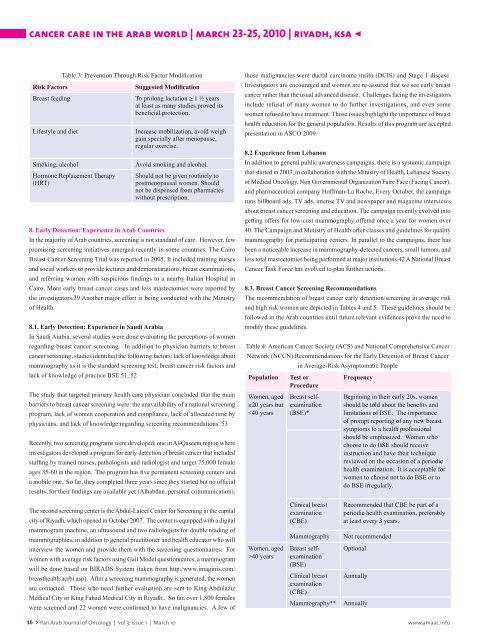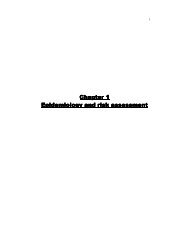Pan Arab Journal of Oncology - Arab Medical Association Against ...
Pan Arab Journal of Oncology - Arab Medical Association Against ...
Pan Arab Journal of Oncology - Arab Medical Association Against ...
Create successful ePaper yourself
Turn your PDF publications into a flip-book with our unique Google optimized e-Paper software.
cancer care in the arab world | march 23-25, 2010 | riyadh, ksa <<br />
Table 3: Prevention Through Risk Factor Modification<br />
Risk Factors Suggested Modification<br />
Breast feeding To prolong lactation ≥ 1 ½ years<br />
at least as many studies proved its<br />
beneficial protection.<br />
Lifestyle and diet Increase mobilization, avoid weigh<br />
gain specially after menopause,<br />
regular exercise.<br />
Smoking, alcohol Avoid smoking and alcohol.<br />
Hormone Replacement Therapy<br />
(HRT)<br />
Should not be given routinely to<br />
postmenopausal women. Should<br />
not be dispensed from pharmacies<br />
without prescription.<br />
8. Early Detection: Experience in <strong>Arab</strong> Countries<br />
In the majority <strong>of</strong> <strong>Arab</strong> countries, screening is not standard <strong>of</strong> care. However, few<br />
promising screening initiatives emerged recently in some countries. The Cairo<br />
Breast Cancer Screening Trial was reported in 2005. It included training nurses<br />
and social workers to provide lectures and demonstarations, breast examinations,<br />
and referring women with suspicious findings to a nearby Italian Hospital in<br />
Cairo. More early breast cancer cases and less mastectomies were reported by<br />
the investigators.39 Another major effort is being conducted with the Ministry<br />
<strong>of</strong> Health.<br />
8.1. Early Detection: Experience in Saudi <strong>Arab</strong>ia<br />
In Saudi <strong>Arab</strong>ia, several studies were done evaluating the perceptions <strong>of</strong> women<br />
regarding breast cancer screening. In addition to physician barriers to breast<br />
cancer screening, studies identified the following factors: lack <strong>of</strong> knowledge about<br />
mammography as it is the standard screening test, breast cancer risk factors and<br />
lack <strong>of</strong> knowledge <strong>of</strong> practice BSE.51, 52<br />
The study that targeted primary health care physician concluded that the main<br />
barriers to breast cancer screening were: the unavailability <strong>of</strong> a national screening<br />
program, lack <strong>of</strong> women cooperation and compliance, lack <strong>of</strong> allocated time by<br />
physicians, and lack <strong>of</strong> knowledge regarding screening recommendations. 53<br />
Recently, two screening programs were developed; one in Al-Qaseem region where<br />
investigators developed a program for early detection <strong>of</strong> breast cancer that included<br />
staffing by trained nurses, pathologists and radiologist and target 75,000 female<br />
ages 35-60 in the region. The program has five permanent screening centers and<br />
a mobile one. So far, they completed three years since they started but no <strong>of</strong>ficial<br />
results, for their findings are available yet (Alhabdan, personal communication).<br />
The second screening center is the Abdul-Lateef Center for Screening in the capital<br />
city <strong>of</strong> Riyadh, which opened in October 2007. The center is equipped with a digital<br />
mammogram machine, an ultrasound and two radiologists for double reading <strong>of</strong><br />
mammographies, in addition to general practitioner and health educator who will<br />
interview the women and provide them with the screening questionnaires. For<br />
women with average risk factors using Gail Model questionnaires, a mammogram<br />
will be done based on BIRADS System (taken from http:/www.imaginis.com/<br />
breasthealth/acrbi.asp). After a screening mammography is generated, the women<br />
are contacted. Those who need further evaluation are sent to King Abdulaziz<br />
<strong>Medical</strong> City or King Fahad <strong>Medical</strong> City in Riyadh.. So far, over 1,800 females<br />
were screened and 22 women were confirmed to have malignancies. A few <strong>of</strong><br />
those malignancies were ductal carcinoma insitu (DCIS) and Stage 1 disease.<br />
Investigators are encouraged and women are re-assured that we see early breast<br />
cancer rather than the usual advanced disease. Challenges facing the investigators<br />
include refusal <strong>of</strong> many women to do further investigations, and even some<br />
women refused to have treatment. Those issues highlight the importance <strong>of</strong> breast<br />
health education for the general population. Results <strong>of</strong> this program are accepted<br />
presentation in ASCO 2009.<br />
8.2 Experience from Lebanon<br />
In addition to general public awareness campaigns, there is a systemic campaign<br />
that started in 2003, in collaboration with the Ministry <strong>of</strong> Health, Lebanese Society<br />
<strong>of</strong> <strong>Medical</strong> <strong>Oncology</strong>, Non Governmental Organization Faire Face (Facing Cancer),<br />
and pharmaceutical company H<strong>of</strong>fman-La Roche. Every October, the campaign<br />
runs billboard ads, TV ads, intense TV and newspaper and magazine interviews<br />
about breast cancer screening and education. The campaign recently evolved into<br />
getting <strong>of</strong>fers for low-cost mammography <strong>of</strong>fered once a year for women over<br />
40. The Campaign and Ministry <strong>of</strong> Health <strong>of</strong>fer classes and guidelines for quality<br />
mammography for participating centers. In parallel to the campaigns, there has<br />
been a noticeable increase in mammography-detected cancers, small tumors, and<br />
less total mastectomies being performed at major institutions.42 A National Breast<br />
Cancer Task Force has evolved to plan further actions.<br />
8.3. Breast Cancer Screening Recommendations<br />
The recommendation <strong>of</strong> breast cancer early detection/screening in average risk<br />
and high risk women are depicted in Tables 4 and 5. These guidelines should be<br />
followed in the <strong>Arab</strong> countries until future relevant evidences prove the need to<br />
modify these guidelines.<br />
Table 4: American Cancer Society (ACS) and National Comprehensive Cancer<br />
Network (NCCN) Recommendations for the Early Detection <strong>of</strong> Breast Cancer<br />
in Average-Risk Asymptomatic People<br />
Population Test or<br />
Procedure<br />
Frequency<br />
Women, aged Breast self- Beginning in their early 20s, women<br />
≥20 years but examination should be told about the benefits and<br />
40 years<br />
Clinical breast<br />
examination<br />
(CBE)<br />
Mammography Not recommended<br />
Breast self- Optional<br />
examination<br />
(BSE)<br />
Clinical breast Annually<br />
examination<br />
(CBE)<br />
Mammography** Annually<br />
Recommended that CBE be part <strong>of</strong> a<br />
periodic health examination, preferably<br />
at least every 3 years.<br />
16 > <strong>Pan</strong> <strong>Arab</strong> <strong>Journal</strong> <strong>of</strong> <strong>Oncology</strong> | vol 3; issue 1 | March 10 www.amaac.info









